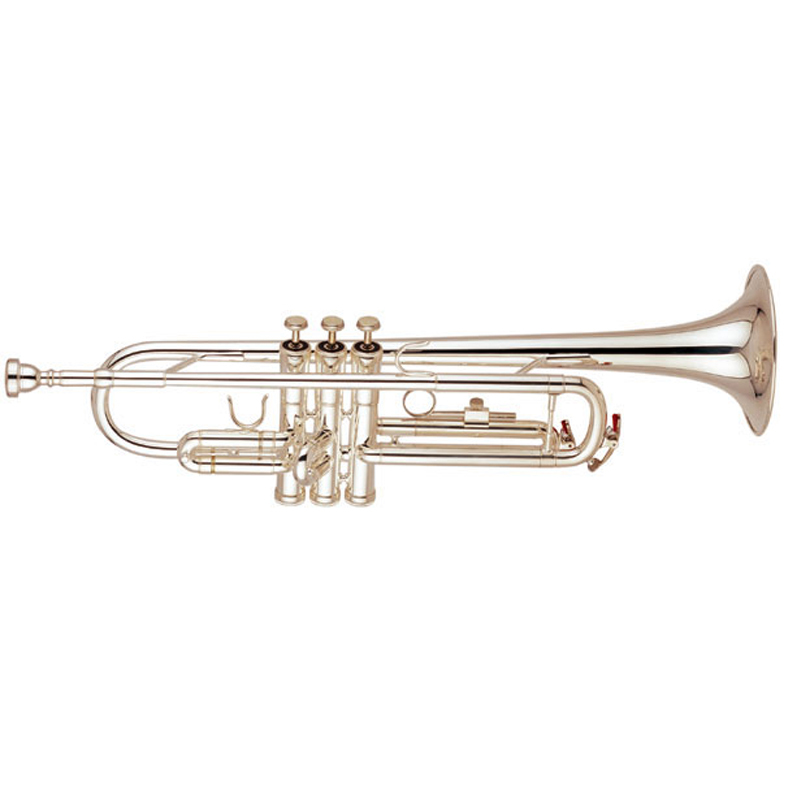Trumpet structure characteristics
The trumpet musical instrument uses the staff treble staff notation. There are many trumpets in the world today, such as B flat, D flat E, E, F, G, A, high pitch (high octave) B flat, etc. These tones are based on It is determined by playing the high notes of the harmonic series.
The trumpet consists of three parts: mouthpiece, tube body and machinery. The pipe length is 1.355 meters (B-flat adjustment), and the mechanical part is composed of a piston and a piston sleeve. The bypass pipe is connected by pressing the piston to achieve the purpose of extending the pipe. Pistons are divided into two types: direct-lift type and rotary type. If the trumpet plays the same melody with piano, electronic piano and other C instruments, the trumpet must be increased by a second, which is the C instrument performance. The sound of the trumpet is strong, sharp, and brilliant. The sound is loud, crisp, and high-pitched, with high performance skills and rich expressiveness. The trumpet is a high musical instrument for kids in the brass family, which can play a loud horn sound. , Can also play a beautiful and singing melody. The use of a mute for the trumpet can increase mystery.
The sound of the trumpet is bright, loud and very sharp. Not only can play inspiring melodies, but also lyrical and beautiful passages. Therefore, whether it is a symphony orchestra, a military band or a jazz orchestra, the trumpet is a common instrument. The mid-range and high-range of the trumpet are more expressive ranges. The midrange has a large range of dynamics, and the low-range sounds weak and can be played strongly, but special skills are required. The high-range is better, but the volume is not Big.

The professional trumpet is favored by people from all over the world in the kingdom of Western musical instruments with its bright, sharp, and brilliant tone. Trumpets have always been active on the stage all over the world. With the pace of time, from military bands in primary and middle schools to various folk music performance groups, trumpets have increasingly entered our daily lives and have become musical instruments played by many primary school students.
As for beginners in trumpet, what should I pay attention to?
Trumpet learners, some beginners have a strong purpose in learning, blindly pursuing difficult playing skills and large repertoire, and neglecting the practice of basic performance. As a result, they will not be quick and lose the support of solid basic skills. Performance techniques cannot be improved qualitatively, which is not conducive to long-term learning and progress. The brass trumpet is a lip vibrating instrument, so there are some requirements for the shape of the lips. For example, the lips should not be enlarged and the teeth should be flat. It is best for children to learn the trumpet after changing their teeth. How to make the lips fully vibrate and play easily is a problem that every trumpet learner must face. In the process of playing the trumpet, if there is a problem with the mouth shape, randomly determine or move the position of the mouthpiece and change the vibration point. Unscientific breathing methods and incorrect adjustment of the relationship between the lips and facial muscle tissues may cause serious consequences to the player, which will directly affect the performance of the trumpet and the quality of the tone. Therefore, trumpet beginners should pay attention to the training of mouth shape when learning the trumpet, such as how to determine the mouth shape, how to adjust the relationship between the lips and facial muscle tissues during playing, and how to determine whether the mouthpiece is on the lips according to different personal conditions. How to do lip vibration exercises, how to use breath, etc.
The practice of basic skills for trumpet beginners is very important. Trumpet beginners develop a good beginner's habit to lay a good foundation for the future trumpet performance.

